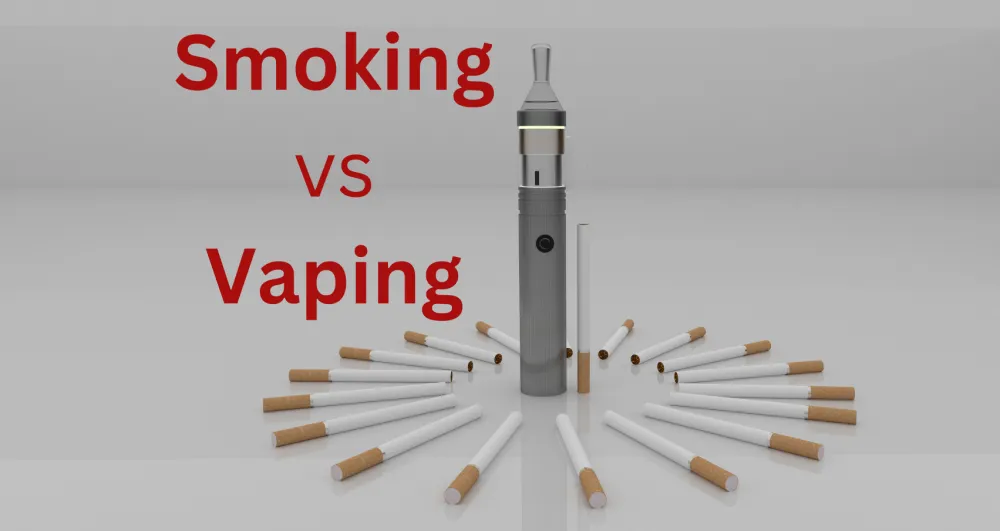Introduction
In the ongoing debate between vaping V.S smoking, individuals often find themselves at a crossroads, trying to navigate through conflicting information to make choices that align with their health and preferences. This article aims to provide a comprehensive overview of both practices, shedding light on their distinctions, impacts, and considerations.
Exploring the World of Vaping
Vaping has surged in popularity in recent years, touted as a safer alternative to traditional smoking. The experience of vaping involves inhaling vapor produced by an electronic device, typically containing nicotine, flavorings, and other chemicals.
Vaping offers a variety of flavors, catering to diverse preferences, and the ability to control nicotine intake levels, making it appealing to those seeking alternatives to conventional cigarettes.
Understanding Smoking: Tradition vs. Health Concerns
Smoking, deeply ingrained in many cultures worldwide, remains a prevalent habit despite widespread awareness of its health risks. The act of smoking involves burning tobacco, releasing harmful chemicals such as tar, carbon monoxide, and various carcinogens.
While smoking provides a ritualistic experience for some, it poses significant health hazards, increasing the risk of various diseases, including lung cancer, heart disease, and respiratory issues.
The Health Implications: Comparing Risks
Vaping: Is it Truly Safer?
Despite perceptions of safety, vaping is not without its risks. While it eliminates exposure to many of the harmful chemicals found in traditional cigarettes, it still poses potential health concerns.
Studies suggest that vaping may contribute to respiratory issues, cardiovascular problems, and addiction, particularly among young adults and non-smokers. The long-term effects of vaping remain a topic of ongoing research and debate within the scientific community.
Smoking: A Well-Established Threat
In contrast, the dangers of smoking are well-documented and widely acknowledged. Tobacco smoke contains thousands of chemicals, many of which are known to cause cancer and other serious health conditions.
Regular smoking is associated with a myriad of adverse health outcomes, including reduced lung function, increased risk of stroke, and heightened susceptibility to respiratory infections.
Making Informed Choices: Factors to Consider
When weighing the decision between vaping and smoking, several factors come into play:
- Health Considerations: Prioritize your well-being by considering the known risks and potential long-term effects of each method.
- Nicotine Dependency: Evaluate your dependence on nicotine and explore options for gradually reducing or eliminating consumption.
- Social and Environmental Impact: Consider the influence of social norms, peer pressure, and the impact of your choices on those around you.
- Accessibility and Convenience: Assess the availability and accessibility of vaping products versus traditional cigarettes in your area.
FAQs
Q: Is vaping less harmful than smoking?
A: While vaping eliminates many of the harmful chemicals found in cigarettes, it still poses risks to respiratory health and may contribute to nicotine addiction.
Q: Can vaping help me quit smoking?
A: Some individuals have successfully used vaping as a tool for smoking cessation, but its effectiveness varies from person to person. It’s essential to seek professional guidance and explore comprehensive cessation strategies.
Q: What are the potential risks of vaping for non-smokers?
A: Non-smokers who vape may still be exposed to nicotine and other harmful substances, potentially leading to addiction and adverse health effects, particularly among youth.
Q: How does secondhand vape compare to secondhand smoke?
A: Secondhand vape exposure may contain fewer toxins than secondhand smoke, but it still poses risks, especially in enclosed spaces with limited ventilation.
Q: Are there regulations on vaping products?
A: Regulatory measures on vaping products vary by region, with some jurisdictions implementing restrictions on sales, marketing, and product labeling to protect public health.
Q: What are some alternatives to vaping and smoking?
A: Alternative methods for nicotine consumption include nicotine replacement therapies (such as patches or gum), counseling programs, and behavioral interventions tailored to individual needs.
Conclusion
In the ongoing discourse surrounding Vaping V.S Smoking, it’s crucial to approach the topic with an informed perspective, considering the nuances and implications of each method. By understanding the risks, benefits, and considerations involved, individuals can make empowered decisions that prioritize their health and well-being.

